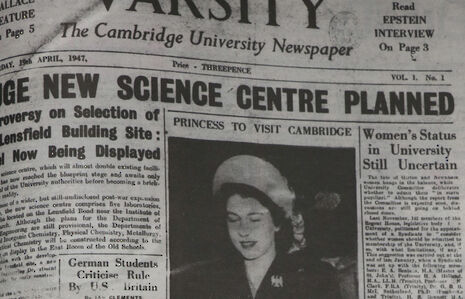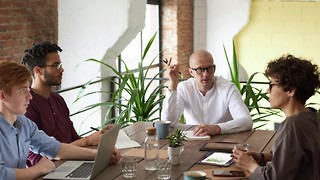
No Cindies, no Churchill, no women receiving actual degrees
Anna Hollingsworth looks at Cambridge life in 1947

Varsity went into print with a bang: “Huge New Science Centre Planned” isn’t exactly an insignificant first headline. In 1947, Varsity was taking baby steps, and the Lensfield Road building – the fine brick complex for Chemistry – was at the blueprint stage, waiting for final approval “before becoming a brick-to-mortar reality.” The science complex wasn’t the only thing that wasn’t quite reality 70 years ago: there was no Cindies, no Churchill, no structure for DNA, and no women receiving actual degrees. But a lot was about to change – 1947 wasn’t a bad year to kick off a newspaper.
Varsity surfaced into a Cambridge that was still living through the WWII aftermath but at same time waving goodbye to wartime restrictions. Cambridge as a town – it was still four years away from city status – was starting to bloom, developing as a regional administrative centre, with an influx of civil servants and undergrads alike. Fitzbillies had been churning out Chelsea buns for over 20 years on Trumpington Street, and the Eagle pub had been quenching thirst for several centuries. It wasn’t known as the DNA Pub yet, though – Crick and Watson had not yet “discovered the secret of life” – and the graffiti by WWII airmen that tourists now flock in to see was still quite fresh.
“Where rationing was still in place, Cambridge was definitely not lacking in food for thought”
Food was still rationed, and life in general was on the austere side of things. At Newnham, heating meant coal fires and personal hygiene equalled baths limited to two per week. Issues with communal bathrooms were already there, though: Katharine Whitehorn, journalist and Newnham undergrad from 1947-50, recalls in a Daily Mail interview how “one girl had one every day, correctly guessing that half of the girls never bathed at all.”
The bulk of undergrads coming up would be used to challenging surroundings, though. The UK still had compulsory military service, and 90 per cent of undergrad places had to be filled by ex-service applicants. Men in general did their service first: for example, those who left school in 1946 were unable to come up before 1948 – talk about gap yah experiences.
But limited food and personal hygiene or a stint in the military did nothing to stop applicants from trying their hand at Cambridge entrance exams – it was written exams back in day – and the University was experiencing a considerable rise in student numbers: in 1946-47, there were 5,865 undergrads, and the number of research students hit 578. The numbers may have seemed big at the time, but bigger expansions were only looming in the future: Murray Edwards, Churchill, Robinson, Darwin, Wolfson, Clare Hall and Lucy Cavendish hadn’t been conceived yet, while Hughes Hall, St Edmund’s, and Homerton were waiting to be recognised as colleges.
The increase in student numbers has at least partly access to thank – turns out access was a big word already then. The Ministry of Education increased the number of State scholarships for universities in 1947, and also Local Authority awards became more generous. Social extremes were starting to level off in post-war Cambridge, but at the same time greater access to scholarships meant greater competition for places. Some writers of the time note how this was reflected in an increasingly hard-working and decreasingly rowdy student body – what with exception of the Senate House glass being smashed by an explosive charge on Guy Fawkes Day in ’48.
It wasn’t all work and no play, though: there was an increased interest in religion, writers noted the high standard of Cambridge drama – even if ADC wasn’t exactly a new kid on the block, having produced plays for over 90 years at that point – and the Pitt Club – “a social organisation”, as the first Varsity put it – was moving into new lodgings on Jesus Lane.
Where rationing was still in place, Cambridge was definitely not lacking in food for thought. Francis Crick was working away in the Strangeways Research Laboratory, having just made the transition from physics to biology – good career call there – while Rosalind Franklin had got her PhD from Cambridge two years earlier and moved to France, and James Watson was only 19 and hadn’t set foot in the UK yet. Iris Murdoch was doing her philosophy postgrad in Newnham, and popped into a Wittgenstein lecture – by, not about, Wittgenstein, who had recently left Cambridge. Bertrand Russell was still holding fort at Cambridge. Dr Jennifer Trusted recalled her 40s encounter with the philosopher to Varsity in 2008: “Once I was locked in a room with Bertrand Russell, it was completely accidental. I was awestruck of course, but he was a real sweetie – he didn’t try anything on.”
With all the intellectual rigour hanging about, things like gender equality can easily take the backseat. ‘Women’s Status in University Still Uncertain’, the first Varsity told its readers (the piece was given one column, with the bulk of the front page given to the new science building). The women studying at Girton and Newnham did all the work their male counterparts did, but were only awarded ‘the title of a degree’ for their efforts. However, in December 1947, after an unopposed vote, women were admitted to fully equal status with men, and Girton and Newnham became colleges of the University.
It wasn’t all emancipation and equality, though: there were no mixed colleges, and visitors of the opposite sex were under curfew, 10:30pm for Trinity, and 10pm for Tit Hall. However, students weren’t exactly rising to the barricades before or after women were admitted. Sylvia Hallam started at Newnham in ’45, becoming part of the first cohort of women to receive a proper degree in 48. She recalled her time at Cambridge during women’s admission at an alumni event: “There was so much else demanding our time and attention. For me there was the whole new experience of being away from home; the strange social milieu of older neighbours from different worlds; the full timetable of lectures and labs and library work and essays and tutorials involved in a science course.”
To be fair, there was definitely enough going on to keep students’ minds off work and questions of gender equality. May Balls had already been shifted from May to June a while back, but at least they still stayed true to the ‘ball’ bit of their name. The 40s balls had traditional dance orchestras as headliners and ballroom dancing as their main ents. It wasn’t all steeped in tradition, though: dance cards from John’s May Ball show students’ expanding dance preferences, with ball-goers partying away to fox-trot, samba, tango, and quick-step – definitely involving more skill than my silent disco antics. The menu cards at the same ball were printed in French up until the middle of the century because of the popularity of French cuisine. So much for midnight burgers and pizza for breakfast.
Cambridge may not have known the structure for DNA, but it definitely knew how to work hard, play hard – and make headlines out of it
 Features / How sweet is the en-suite deal?13 January 2026
Features / How sweet is the en-suite deal?13 January 2026 Comment / Will the town and gown divide ever truly be resolved?12 January 2026
Comment / Will the town and gown divide ever truly be resolved?12 January 2026 News / 20 vet organisations sign letter backing Cam vet course13 January 2026
News / 20 vet organisations sign letter backing Cam vet course13 January 2026 Arts / Fact-checking R.F. Kuang’s Katabasis13 January 2026
Arts / Fact-checking R.F. Kuang’s Katabasis13 January 2026 Music / Inside Radiohead’s circle13 January 2026
Music / Inside Radiohead’s circle13 January 2026









